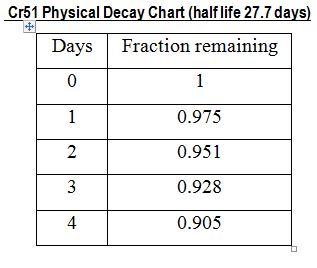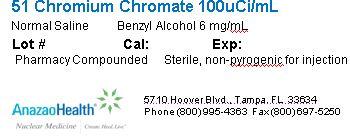SODIUM CHROMATE 51 solution
Sodium Chromate 51 by
Drug Labeling and Warnings
Sodium Chromate 51 by is a Prescription medication manufactured, distributed, or labeled by AnazaoHealth Corporation. Drug facts, warnings, and ingredients follow.
Drug Details [pdf]
- DESCRIPTION
-
INDICATIONS AND USAGE
Cr51 is indicated for use in determining red blood cell volume or mass, studying red blood cell survival time (in conditions such as hemolytic anemia), and evaluating blood loss
Mechanism of Action
The chromium in this agent is present as the dianionic chromate ion in which form it appears to bind to the red blood cell in two steps, initially by a rapid but reversible attachment to the cell membrane followed by a slower nearly irreversible binding to intracellular hemoglobin and reduction to the anionic state. It has been suggested that the slow rate of uptake is dependent on the rate at which chromate can penetrate the cell membrane. Binding is maintained until the red blood cells are sequestered by the spleen or until elution of the chromium occurs into the plasma. The chromium is then readily excreted mainly in the urine. Once liberated by elution or erythrocyte senescence, chromium 51 is not available for relabeling of red cells.
In normal individuals the erythrocyte survival half-time T ½ as measured by the chromium 51 "random labeling" technique, generally ranges between 25 and 35 days. This apparent short survival time, when compared to the 120 day life span of the red blood cells, is due to the elution of chromium from the cells and to cell damage that probably occurs during the process of withdrawing them from the body and labeling. Subnormal T ½ may be indicative of blood toss, sequestration of red blood cells by the spleen, or shortened cell viability, as occurs In hemolytic anemia
- CONTRAINDICATIONS
- DOSAGE AND ADMINISTRATION
- PACKAGE LABEL.PRINCIPAL DISPLAY PANEL
-
INGREDIENTS AND APPEARANCE
SODIUM CHROMATE 51
sodium chromate 51 solutionProduct Information Product Type HUMAN PRESCRIPTION DRUG Item Code (Source) NDC: 51808-101 Route of Administration INTRAVENOUS Active Ingredient/Active Moiety Ingredient Name Basis of Strength Strength CHROMIUM CR-51 (UNII: 9QAU17N705) (CHROMIUM CR-51 - UNII:9QAU17N705) CHROMIUM CR-51 1 mCi in 5 mL Inactive Ingredients Ingredient Name Strength BENZYL ALCOHOL (UNII: LKG8494WBH) 30 mg in 5 mL SODIUM CHLORIDE (UNII: 451W47IQ8X) Packaging # Item Code Package Description Marketing Start Date Marketing End Date 1 NDC: 51808-101-02 5 mL in 1 VIAL Marketing Information Marketing Category Application Number or Monograph Citation Marketing Start Date Marketing End Date Unapproved drug other 06/19/2012 Labeler - AnazaoHealth Corporation (011038762) Establishment Name Address ID/FEI Business Operations AnazaoHealth Corporation 011038762 MANUFACTURE(51808-101)
© 2025 FDA.report
This site is not affiliated with or endorsed by the FDA.

